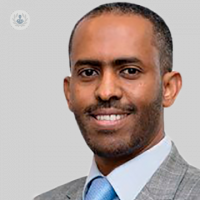How to treat slipped disc in the neck (cervical spine)
Escrito por:Most people are familiar sciatica or pain in the back and leg caused by a slipped disc in the back. What is less commonly experienced, but can potentially cause significantly more disability, is slipped disc in the neck or the cervical spine.

Mr Ahmed Ibrahim is a highly experienced neurosurgeon who specialises in this condition. We recently spoke with him to discuss how it should be treated.
What are the causes of slipped disc?
One of the main causes of slipped disc is age-related wear and tear changes typically seen in the adult spine. There are genetic and environmental factors that predispose some individuals to develop herniations, which are not fully understood at present. The age of onset of disc prolapse is variable but can often begin after the age 30 but can sometimes affect those in their 20’s. Trauma is another less common cause of disc prolapse.
What are the symptoms of neck disc prolapse?
There are two types of symptoms:
1) Neck and arm symptoms
Disc prolapses that cause entrapment of the neck nerves result in pain which often starts in the neck and can radiate to the arm or the shoulder blades. In addition to pain, there may be numbness, tingling or pins and needles affecting the arms, hands or fingers.
2) Potentially severe neurological disability
If a slipped disc compresses the spinal cord directly, then this can lead to spinal cord dysfunction that can lead to numbness of fingertips, Loss of hand dexterity, limb weakness, imbalance when walking, bladder dysfunction, and if left untreated it can lead to inability to walk. Loss of hand dexterity is often noticed when tying shoelaces, wearing jewellery, buttoning up or zipping clothing.
How is slipped disc investigated and treated?
The best way to confirm a diagnosis of the condition is by performing MRI scan. Other modalities such as X-Ray and CT scans can also be helpful. Further specialist investigations such as neurophysiological tests may also be required.
How should cervical neck disc prolapse be treated?
Often simple disc prolapse related pain will respond to physiotherapy and avoidance of triggers. Injections can be very effective to deal with the pain in the majority of patients but if the size of the disc prolapse is large or the compression is causing weakness and in the event injections do not result in significant improvement then surgery would become indicated.
The good news is that if disc prolapse that causes disc or cord compression is picked up and treated early, a full recovery is achievable.
What are the different types of cervical spine surgery?
Disc replacement
This form of treatment is an excellent option in younger individuals or those who lead a very active lifestyle and wish to preserve neck motion. This is relatively new treatment modality, and a careful specialist evaluation is need to determine suitability.
Discectomy and fusion surgery
A standard treatment option that is tried and tested is the complete removal of the herniated disc and its replacement of a cage that promotes fusion. The option removes the defective disc fully and has an excellent outcome for most patients.
Posterior cervical foraminotomy
For patients who experience pain from compression of a single nerve root without compression of the cord can be candidates for cervical foraminotomy. The surgery is performed through the back of the neck and can be performed through keyhole surgery.
Posterior cervical fusion
When multiple discs in the neck cause cord compression, a good option is removing the bones in the back of the spinal canal, by performing laminectomy followed by instrumented stabilisation. This can decompress the spinal cord over a long segment and has an excellent outcome.
How long does it take to recover from cervical spine surgery?
Surgery in the cervical spine is generally speaking very well tolerated. Hospital stay is often as short as 1 night but can be as long as 3 nights.
The vast majority of patients will experience an improvement in their symptoms soon after surgery.
In summary, if a person experiences persistent pain, numbness, weakness or hand dexterity issues, then early consultation with a specialist is recommended. Non-surgical treatment may be advised initially, but surgical intervention may be necessary. If you believe you may have symptoms of slipped disc and would like it to be investigated, we recommend getting in contact with a leading neurosurgeon such as Mr Ahmed Ibrahim. Click here to visit his profile today.


